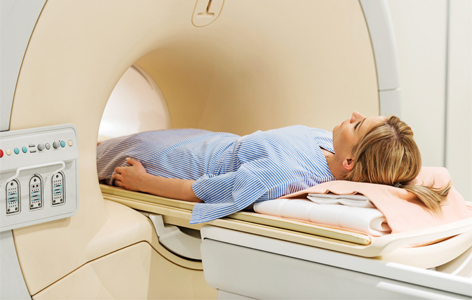Home page Description:
Early screening prevents breast cancer-related death among childhood cancer survivors.
Posted On: April 18, 2016

Image Caption:
Magnetic resonance imaging (pictured here) is the most effective screening method for detecting early forms of breast cancer in survivors of Hodgkin’s lymphoma.
Magnetic resonance imaging (MRI) is the most effective screening method for detecting early forms of breast cancer in survivors of Hodgkin’s lymphoma.
Women treated with chest radiation in their teenage years for Hodgkin’s lymphoma are at increased risk of developing breast cancer later in life. While early screening in this population may help to save lives, clinical data to support this approach are lacking. Consequently, clinical practice guidelines are inconsistent—some women receive early screening, while others do not.
A UHN study has shed light on this issue by producing the first compelling evidence that early screening can reduce deaths from breast cancer among women who were treated with chest radiation therapy for Hodgkin’s lymphoma as teenagers. Dr. David Hodgson, a clinical researcher at PM Cancer Centre, led the study.
Using a mathematical model that incorporates data from dozens of clinical studies, the researchers found that starting breast cancer screening at age 25 significantly reduced the risk of breast cancer-related death among survivors of Hodgkin’s lymphoma. Moreover, the model predicted that screening programs that use MRI are more effective at reducing breast cancer-related deaths than those using mammography. The difference in these screening methods is substantial: to prevent one breast-cancer related death, 259 women would need to be invited to mammography-based screening, versus 80 women using MRI-based screening.
In light of his findings, Dr. Hodgson advises women who were treated for Hodgkin’s lymphoma to talk to their doctors about early screening for breast cancer.
This work was supported by the Canadian Cancer Society, the Pediatric Oncology Group of Ontario, Cancer Care Ontario and The Princess Margaret Cancer Foundation.
Impact of early breast cancer screening on mortality among young survivors of childhood Hodgkin's lymphoma. Hodgson DC, Cotton C, Crystal P, Nathan PC. Journal of the National Cancer Institute. 2016 March 1. doi: 10.1093/jnci/djw010. [Pubmed abstract]
Women treated with chest radiation in their teenage years for Hodgkin’s lymphoma are at increased risk of developing breast cancer later in life. While early screening in this population may help to save lives, clinical data to support this approach are lacking. Consequently, clinical practice guidelines are inconsistent—some women receive early screening, while others do not.
A UHN study has shed light on this issue by producing the first compelling evidence that early screening can reduce deaths from breast cancer among women who were treated with chest radiation therapy for Hodgkin’s lymphoma as teenagers. Dr. David Hodgson, a clinical researcher at PM Cancer Centre, led the study.
Using a mathematical model that incorporates data from dozens of clinical studies, the researchers found that starting breast cancer screening at age 25 significantly reduced the risk of breast cancer-related death among survivors of Hodgkin’s lymphoma. Moreover, the model predicted that screening programs that use MRI are more effective at reducing breast cancer-related deaths than those using mammography. The difference in these screening methods is substantial: to prevent one breast-cancer related death, 259 women would need to be invited to mammography-based screening, versus 80 women using MRI-based screening.
In light of his findings, Dr. Hodgson advises women who were treated for Hodgkin’s lymphoma to talk to their doctors about early screening for breast cancer.
This work was supported by the Canadian Cancer Society, the Pediatric Oncology Group of Ontario, Cancer Care Ontario and The Princess Margaret Cancer Foundation.
Impact of early breast cancer screening on mortality among young survivors of childhood Hodgkin's lymphoma. Hodgson DC, Cotton C, Crystal P, Nathan PC. Journal of the National Cancer Institute. 2016 March 1. doi: 10.1093/jnci/djw010. [Pubmed abstract]




